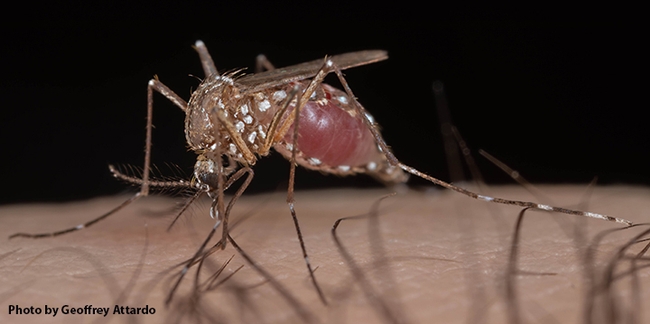
By Geoff Attardo
Assistant Professor of Entomology and Nematology at UC Davis
California's changing climate is creating a myriad of public health concerns. Wildfires, intense heatwaves, and a drought are the most readily apparent. However, increasingly temperate winters are also facilitating the spread of invasive disease-spreading mosquitoes throughout the state. Just as our fire authorities need a robust set of tools to address wildfires, it is critical that mosquito control and public health professionals have a wide range of tools to protect Californians from mosquito-borne diseases.
The growing presence of Aedes aegypti mosquitoes, which can transmit the viruses that cause Zika, dengue, chikungunya, and yellow fever as well as the parasite that causes heartworm in pets, is a major public health threat. In 2013 this invasive species was detected in the Central Valley and has been found in California every year since. These mosquitoes cohabitate with humans and often hitchhike facilitating their spread.
Aedes aegypti lay eggs in flowerpots, water storage containers or anything capable of holding small amounts of water. Part of the problem, as highlighted in our research in Frontiers in Tropical Diseases, is that these mosquitoes have cryptic breeding sites in residential areas where mosquito control agencies can't easily inspect and treat.
In addition, their eggs can dry out and then hatch when rehydrated. In fact, when Aedes aegypti were detected in 2014 in the city of Exeter there was a large eradication effort. The effort appeared successful, as they were no longer detectable in 2015. Yet, the mosquitoes were detected in Exeter again in 2018. The unique biology of this invasive species has allowed it to expand its geographical range and today they are present in more than 300 cities in California.
Another key factor is their inherent resistance to a class of insecticides called pyrethroids, which have been a mainstay for adult mosquito control because they have low toxicity to humans and other animals. Work from our lab and the California Department of Public Health found increasing insecticide resistance in these mosquitoes (Parasites and Vectors) which limits the ability of mosquito control agencies to act against adult mosquitoes in a time of crisis.
In order to protect public health, mosquito control agencies need effective tools in their toolbox. One innovative approach takes advantage of the fact that male mosquitoes do not bite; only female mosquitoes bite and can spread viruses. This approach works by releasing sterile male Aedes aegypti mosquitoes. These male-only mosquitoes carry a self-limiting gene that prevents their female offspring from surviving. When they mate with females, this reduces the abundance of biting females in the next generation. One of the benefits of this species-specific approach is that it only targets the Aedes aegypti mosquito. This means that wildlife, such as butterflies and bees, are unharmed.
The public health threat of Aedes aegypti cannot be overstated. The World Health Organization (WHO) estimates that dengue fever causes approximately 40,000 deaths a year and Zika virus, of which there were over 5,100 symptomatic domestic cases in 2016, is known to cause serious birth defects and miscarriage as well as Guillain-Barré syndrome. The WHO also said “the potential public health benefit of practical and effective new tools to reduce or even eliminate diseases such as malaria and dengue is clear and widely recognized.”
A company called Oxitec is working with government agencies to bring its innovative mosquito control technology to the U.S. In August, they announced they are seeking regulatory approvals to expand their pilot program to bring their Friendly™ Aedes aegypti technology to California. I encourage regulators to allow the company to work with mosquito control agencies to determine the technology's effectiveness in California.
It's clear that we need efficient mosquito control tools, and we cannot wait until we have a public health emergency to act. As we have seen with the COVID pandemic it is critical to have an infrastructure in place, especially one that includes innovative – and proven – technologies, to help public health and mosquito controls stay ahead of the curve.
Attached Images:
